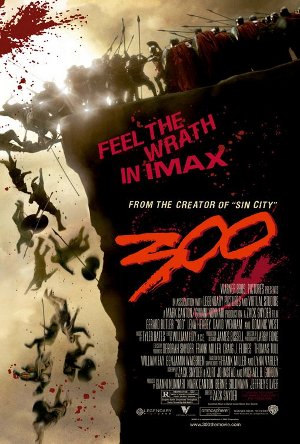- Title: 300
- IMDB: link

 300 is the artistic retelling of the legend of 300 Spartans who stood against the mighty force of the entire Persian army, numbering in the millions, and held their ground at the Battle of Thermopylae in 480 B.C. Ripped from the pages of Frank Miller‘s graphic novel, the film, as Miller and Lynn Varley‘s original work did before it, celebrates the legend of the events rather than trying to produce a historically accurate account. And so I’ll judge it on that basis alone.
300 is the artistic retelling of the legend of 300 Spartans who stood against the mighty force of the entire Persian army, numbering in the millions, and held their ground at the Battle of Thermopylae in 480 B.C. Ripped from the pages of Frank Miller‘s graphic novel, the film, as Miller and Lynn Varley‘s original work did before it, celebrates the legend of the events rather than trying to produce a historically accurate account. And so I’ll judge it on that basis alone.
In terms of capturing the look and feel of Miller’s work the film is a huge success. In terms of translating the story to screen it struggles at times. Don’t get me wrong, 300 is quite enjoyable and far better than I feared, but as a longtime fan of Miller’s work it’s not as good as I hoped. It’s epic, but also cheesy. It’s brutal, but also timid. And sadly, it will remind you of better films you would rather be watching.
As Xerxes (Rodrigo Santoro) King of Persia, and living God to his countless minions, expands into Greece he runs afoul of Sparta’s King Leonidas (Gerard Butler). Unwilling to bend his city state to the will of the power-hungry despot Xerxes, Leonides hatches a plan. With 300 of his best warriors he will meet the Persian army in a narrow passage through the cliffs where the Persians have landed.
As Leonidas and his men set out to protect the honor and freedom of Greece, and more important Sparta itself, Leonidas’ Queen Gorgo (Lena Headey) fights with the council to win her husband support and more troops from the council while also facing off advances and schemes of an ambitious politician (Dominic West).
Several things work in the film. To start with the look of the CGI is almost perfect. You believe these battles and scenes are taking place in Greece, instead of a soundstage in Montreal.
The film also does well in capturing the narrative thread of a graphic novel and Miller’s trademark blood splatter. And like Sin City (a much, much better film) you can actually see the comic panels coming to life before your eyes, especially during slow motion battle scenes where actual frames can be easily recognized.
Where the film falls short however is failing to better adapt words and dialogue which may work well on the written page, but at times appear corny on screen. The film does good in pushing the overall message of the film, but at times gets off-track in WTFWT? type moments that will leave you scratching your head or even groaning and shaking your head in despair.
The acting, not surprisingly with such a large cast, is a mixed bag. Butler provides a strong lead, and Headey is both tough and beautiful in what is without doubt the script’s best role. The villains however aren’t as strong. The faceless minions work well, but those few with actual lines fair far worse. Andrew Tiernan is more bizarre than believable as the traitor Ephialtes, West is pretty far gone over-the-top as a power-mad politician, and I’m not sure how Santoro didn’t get laughed off the soundstage every time he opened his mouth as he appears to be auditioning for gay Mardi Gras.
Also troubling is the number of films, better films, 300 will remind you of. From Braveheart to The Two Towers to Gladiator the film feels too much like something we’ve already seen done before, and done better.
What truly scares me is 300 is just good enough to garnish cult support and rake in enough cash to greenlight director’s Zack Snyder‘s next project – Alan Moore’s The Watchmen; from what I’ve seen here I seriously doubt Snyder has the ability to pull off such an enormous feat.
Even with all of these flaws 300 is an engaging film and pretty good popcorn flick that many will enjoy on a mostly visceral level. Many will think it’s a kick-ass good time. It’s sad the the emotion and deeper meaning of the story, and why the events matter, may be lost.
A final note. I saw the film in it’s IMAX version and I must say that it comes off well in the enlarged print. Often special effects shots can be picked apart in films expanded onto an IMAX sized screen (see The Matrix Reloaded), but here the effects were pristine and the larger screen helped to present the beauty and the bloodshed of Miller’s original vision.
